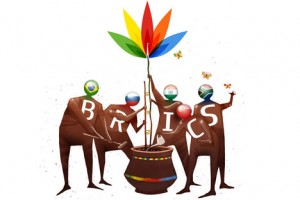The acronym BRIC (meaning Brazil, Russia, India and China) was first used in 2001 by Jim O’Neill, an economist at Goldman Sachs, to describe the emerging markets, in a report forecasting global economic trends over the next half century. In 2010, South Africa was invited to join the group which changed the name in BRICS. These emerging countries are known for a rapid pace of development, encompassing over 25% of the world’s land, 40% of the world’s population and the competitive advantage of holding important natural resources. Its main competitor is G7, The Group of Seven (U.S., U.K., Germany, Italy, Canada, France and Japan) which is represented by the largest and wealthiest countries on Earth, threatened to be outgunned by 2050 by BRICS.
Why should we pay attention to the countries forming BRICS? Obviously, because those are the countries that promise to hold the world’s economic power in the future.
To have an overview of all the countries in the world we can classify them in developed countries (G7) and developing countries (BRICS). In only 10 years, the share of global GDP from developing countries has gone from 20% in 2000 to 34% in 2010. For a better understanding of the rapid pace of development of the BRICS countries we can take a look at China which in 1990 accounted for a mere 1.8% of the world’s output while in 2010 reached 9.3% becoming the second largest economy in the world, ahead of France, Germany and Japan.
In the past few years, the 5 countries developed plans related to the creation of institutions to compete with the World Bank and the International Monetary Fund. The discussions were restarted at the last summit hold in Durban, South Africa. The creation of a new development bank is a complex process that will take time. On the background of an unstable global economic climate, this plan looks more like a rescue plan for countries which face financial problems and don’t trust anymore their monetary policies.
The development bank will better coordinate and invest the financial resources of the emerging countries. Thus, there will be well structured funds which will support the development of these countries and a foreign exchange reserve (acting like a financial safety net) to support a currency crisis or a sudden restriction of capital. China and Brazil, the two biggest economies of the group, decided to trade on their own currency, eliminating the American dollar from the equation. The agreement refers to $3o billion per year trade which will not be affected in any way by a new banking crisis. The trade and currency deal are meant to defend the trade between the 5 countries, thus any other shocks to the global financial market will not be felt.
The Bank is supposed to start with a capital of $50 billion but China suggested that this amount should be doubled and is prepared to make a bigger contribution in exchange of a greater power of decision.
The BRICS’s agenda covers issues including trade, global economy, agriculture, health and innovation, terrorism, climate change food and energy security.
The economic climate on Earth is unstable and the largest economies of the world inspire less confidence and security. An increasing number of countries are facing serious problems and came up with different plans that may or may not be successful to save them from a collapse. On the other hand, there is BRICS, a group of countries with natural resources and new views for a better coordination of the world’s economy.
It’s important to foresee the possible switch of power from West to East, from today’s seven largest economies to the economies forming BRICS.
BRICS – A new player in the world’s economy by Silvia Gabor


